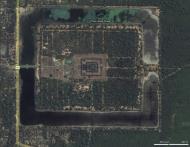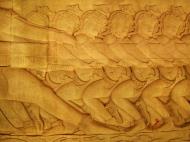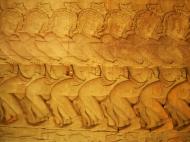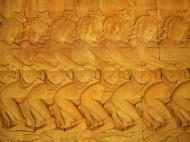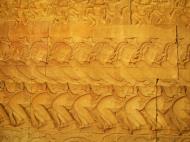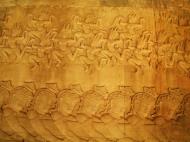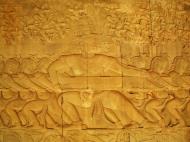Angkor Wat's marvelous bas relief - The churning of the ocean of milk
Samudra Manthan or (Devanagari: ?????? ????)In Hinduism, Samudra manthan or The churning of the ocean of milk is one of the most famous episodes in the Puranas and is celebrated in a major way every twelve years in the festival known as Kumbha Mela. The story appears in the Bhagavata Purana, the Mahabharata and the Vishnu Purana.
Samudra Manthan is also known as - Samudra manthanam - Manthanam is the Sanskrit equivalent of Manthan meaning 'to churn'. Sagar manthan - Sagar is another word for Samudra, both meaning an ocean or large water body. Kshirsagar manthan - Kshirsagar means the ocean of milk. Kshirsagar = Kshir (milk) + Sagar (ocean).
The story of Samudra Manthan
Indra, the King of Devatas, while riding on an elephant, came across a sage named Durvasa who offered him a special garland. Indra accepted the garland, placing it on the trunk of the elephant. The elephant, irritated by the smell of the garland, threw it to the ground. This enraged the sage as the garland was a dwelling of Sri (fortune) and was to be treated as prasada. Durvasa Muni cursed Indra and all devas to be bereft of all strength, energy, and fortune.
In battles that followed this incident, Devas were defeated and Asuras (demons) led by king Bali gained control of the universe. Devas sought help from Lord Vishnu who advised them to treat asuras in a diplomatic manner. Devas formed an alliance with asuras to jointly churn the ocean for the nectar of immortality and to share it among them. However, Lord Vishnu told Devas that he would arrange that they alone obtain the nectar.
Churning the Milky Ocean
The churning of the Ocean of Milk was an elaborate process. Mount Mandaranchal was used as the dasher (churning tool), and Vasuki, the king of serpents, became the churning rope. The gods held the tail of the snake, while the demons (Asuras) held its head, and they pulled on it alternately causing the mountain to rotate, which in turn churned the ocean. However, once the mountain was placed on the ocean, it began to sink. Vishnu in his second incarnation, in the form of a turtle Kurma, came to their rescue and supported the mountain on his back.
Note that the Mahabharata version of the story differs in many respects from the one in the various Puranas such as Bhagawat, Brahma-vaivarta, and Agni. For example, in Mahabharata, it was not Vishnu who took the Kurma avatara, but the Akupara, the king of tortoises, who did it on request from Devas and Asuras.
Halahal (Also called 'kalakuta')
During the Samudra Mathan by the gods and demons, a pot of poison, Halahala, also came out of the ocean. This terrified the gods and demons because the poison was so toxic that it might have destroyed all of creation. On the advice of Vishnu, gods approached Shiva for help and protection. Out of compassion for living beings, Shiva drank the poison. It was so potent that it changed the color of Shiva's neck to blue. For this reason, he is also called Neelakantha (the blue-necked one, nila = "blue", kantha = "throat").
Ratnas
All kinds of herbs were cast into the ocean and fourteen Ratnas (gems or treasures) were produced from the ocean and were divided between asuras and gods. These were
Lakshmi: the Goddess of Fortune and Wealth – Vishnu's consort
Kaustubha: the most valuable jewel in the world
Parijat: the divine flowering tree with blossoms that never fade or wilt
Varuni: goddess and creator of alcohol
Dhanvantari: the doctor
Chandra: the moon
Kamadhenu: the wish-granting divine cow
Kalpavriksha: the wish-granting tree
Airavata: the elephant of Indra
Apsaras: various divine nymphs like Rambha, Menaka, Punjikasthala, etc.
Uchhaishravas: the divine 7-headed horse
Sharanga: the bow of Vishnu
Shankha: Vishnu's conch
Amrita: the nectar of immortality.This list varies from Purana to Purana and is also slightly different in the epics, the Ramayana and Mahabharata.
'the nectar of immortality
'Finally, Dhanvantari, the heavenly physician, emerged with a pot containing amrita, the heavenly nectar of immortality. Fierce fighting ensued between devas and asuras for the nectar. To protect the nectar from asuras, devas hid the pot of nectar at four places on the earth - Prayag (Allahabad), Haridwar, Ujjain and Nasik. At each of these places, a drop of the nectar spilled from the pot and it is believed that these places acquired mystical power. A Kumbh Mela is celebrated at the four places every twelve years for this reason.
However, the Asuras eventually got hold of the nectar and started celebrating. Frightened, devas (demigods) appealed to Vishnu, who then took the form of Mohini. As a beautiful and enchanting damsel, Mohini distracted the asuras, took the amrita, and distributed it among the Adityas, who drank it. One asura, Rahu, disguised himself as a deva and drank some nectar. Due to their luminous nature, the sun god Surya and the moon god Chandra noticed the switching of sides. They informed Mohini. But before the nectar could pass his throat, Mohini cut off his head with her divine discus, the Sudarshana Chakra. The head, due to its contact with the amrita, remained immortal. To gain revenge on the sun and moon for exposing this, the immortal head occasionally swallows the sun or the moon, causing eclipses. Then, the sun or moon passes through the opening at the neck, ending the eclipse.
The story ends with the rejuvenated Adityas defeating the asuras.
Symbolism of Samudra manthan
The story represents the spiritual endeavor of a person to achieve self-realisation through concentration of mind, withdrawal of senses, control of desires and practice of austerities and asceticism.
The Devas and Asuras represent the positives and negatives respectively of one's personality. The participation of both the Devas and the Asuras signifies that when one is seeking bliss through spiritual practice, one has to integrate and harmonise both the positive and negative aspects and put both the energies to work for the common goal.
The ocean of milk is the mind or the human consciousness. The mind is like an ocean while the thoughts and emotions are the waves in the ocean.
Mandhara, the mountain symbolises concentration. The word Mandhara is made up of two words Mana (mind) and Dhara (a single line) which means holding the mind in one line. This is possible only by concentration.
Mount Mandhara was upheld by Lord Vishnu as a Kurma (tortoise). The tortoise here symbolises the withdrawal of the senses into oneself (just as a tortoise withdraws its head into its shell) as one practices mental concentration and meditation or contemplation.
Vasuki symbolises desire. Vasuki used in the churning of the ocean denotes that the Devas and the demons held desire (to seek immortality) as a rope and churned the mind with the help of concentration and withdrawal of the senses. Desire, if not controlled will overpower and destroy an individual.
The Halahala poison symbolises suffering and pain (counter-reaction of the mind and body) that one undergoes at the beginning of spiritual sadhana (practice). When the mind is subjected to intense concentration, the first thing that comes out of the process is intense suffering and great inner turmoil. These must be resolved otherwise further progress is not possible.
Lord Shiva symbolises the ascetic principle. His role in this story as the consumer of poison suggests that one can deal with the early problems of spiritual life by cultivating the qualities of Lord Shiva, namely, courage, initiative, willingness, discipline, simplicity, austerity, detachment, compassion, pure love and asceticism.
The various precious objects that come out of the ocean during the churning stand for the psychic or spiritual powers (Siddhis) which one gains as s/he progresses spiritually from stage to stage. The seeker should be careful about these powers as they can hamper her/his progress unless s/he uses them judiciously, not for selfish gains but for others' welfare. This is the reason why the Gods and demons distributed these objects as they did not want to lose sight of their original aim which was to gain immortality.
Dhanvantari symbolises health and signifies that immortality (longevity, to be correct) or spiritual success can be achieved only when the body and the mind are in a perfect state of health.
Mohini symbolises delusion of the mind in the form of (or originating from) pride. It is the pride of achievement to which the asuras or the demons succumbed and thus lost sight of their goal. Pride and egoism are the last hurdles one has to overcome in spiritual life before experiencing self-realisation.
The Amrit symbolises the ultimate achievement of the goal of self-realization.
Lakshmi represents universal enrichment which comes as an automatic by-product of the internal self-realization or Amrita
Angkor Wat
Name: Angkor Wat
Creator: Suryavarman II (ruled 1113 – c. 1150).
Date built: first half of the 12th century Primary deity: Vishnu
Architecture: Khmer style
Location: Angkor Thom, Cambodia
Coordinates: 13°24'45?N 103°52'0?EHistory of Angkor Wat
Angkor Wat (or Angkor Vat) is a temple complex at Angkor, Cambodia, built for the king Suryavarman II in the early 12th century as his state temple and capital city. As the best-preserved temple at the site, it is the only one to have remained a significant religious centre since its foundation-first Hindu, dedicated to the god Vishnu, then Buddhist.
The temple is the epitome of the high classical style of Khmer architecture. Angkor Wat combines two basic plans of Khmer temple architecture: the temple mountain and the later galleried temple, based on early South Indian Hindu architecture, with key features such as the Jagati. At the centre of the temple stands a quincunx of towers. Unlike most Angkorian temples, Angkor Wat is oriented to the west; scholars are divided as to the significance of this. The temple is admired for the grandeur and harmony of the architecture, its extensive bas-reliefs and for the numerous devatas (guardian spirits) adorning its walls.
Wat is the Khmer word for temple. Prior to this time the temple was known as Preah Pisnulok, after the posthumous title of its founder, Suryavarman II.
Angkor Wat lies 5.5 km north of the modern town of Siem Reap, and a short distance south and slightly east of the previous capital, which was centred on the Baphuon. It is in an area of Cambodia where there is an important group of ancient structures. The initial design and construction of the temple took place in the first half of the 12th century, during the reign of Suryavarman II (ruled 1113 - c. 1150). In 1177, approximately 27 years after the death of Suryavarman II, Angkor was sacked by the Chams, the traditional enemies of the Khmer.
The new King decided to convert the official religion of the empire from Hindu to Buddhist. Angkor Wat was converted from Hindu to Theravada Buddhist use, which continues to the present day. Angkor Wat is unusual among the Angkor temples in that although it was somewhat neglected after the 16th century it was never completely abandoned, its preservation being due in part to the fact that its moat also provided some protection from encroachment by the jungle. One of the first Western visitors to the temple was Antonio da Magdalena, a Portuguese monk who visited in 1586 and said that it "is of such extraordinary construction that it is not possible to describe it with a pen, particularly since it is like no other building in the world. The temple was popularised in the West only in the mid-19th century on the publication of Henri Mouhot's travel notes. Mouhot, like other early Western visitors, was unable to believe that the Khmers could have built the temple, and mistakenly dated it to around the same era as Rome. The true history of Angkor Wat was pieced together only from stylistic and epigraphic evidence accumulated during the subsequent clearing and restoration work carried out across the whole Angkor site.
Suryavarman II
Suryavarman II (posthumous name Paramavishnuloka) was king of the Khmer Empire from 1113 A.D. to 1145-1150 A.D. and the builder of Angkor Wat, which he dedicated to the Hindu god Vishnu.
His reign's monumental architecture, numerous military campaigns and restoration of strong government have led historians to rank Suryavarman as one of the empire's greatest kings.
The king appears to have grown up in a provincial estate in the area of present-day Lopburi in Thailand, at a time of weakening central controls in the empire.
An inscription lists his father as Ksitindraditya, his mother as Narendralashmi.
As a young prince, he maneuvered for power, contending he had a legitimate claim to the throne.
states an inscription, he approved the desire of the royal dignity of his family.Bounding on the head of the elephant of the enemy king, he killed him, as Garuda on the edge of a mountain would kill a serpent.
Scholars have disagreed on whether this language refers to the death of the southern claimant or King Dharanindravarman.
Suryavarman was inaugurated in 1113 A.D. An aged Brahman sage named Divakarapandita oversaw the ceremonies, this being the third time the priest had officiated for an incoming king.
The priest embarked on a lengthy tour of temples in the empire, including the mountaintop Preah Vihear, which he provided with a golden statue of dancing Shiva.
During his decades in power, the king reunited the empire, reversing many of the benign policies of his predecessor, historians believe.
In the west and north, his soldiers expanded the borders to cover new parts of present-day Thailand, Laos and Peninsular Malaysia.
As is common in reconstructing Khmer history, there is plenty of room for debating these and other precise events.
Khmer inscriptions, a major source of information, may exaggerate the empire's accomplishments, while accounts from rival states may do the same with its shortcomings.
Inscriptions in the neighboring Indianized state Champa and accounts left by writers in Dai-Viet, a Vietnam precursor state, say that Suryavarman staged three major but unsuccessful attacks on Dai-Viet, sometimes with the support of Champa.
In 1128 A.D., he is said to have led 20,000 soldiers against Dai-Viet, but they were defeated and chased out.
In 1145, A.D., Suryavarman appears to have invaded Champa, defeated its king and sacked the capital Vijaya.
In subsequent fighting, Cham forces recaptured the capital and killed Harideva.
In addition to war, Suryavarman practiced diplomacy, resuming formal relations with China in 1116 A.D. A Chinese account of the 13th Century says that the Khmer embassy had 14 members, who after reaching Chinese soil were given special court garments. The embassy went home the following year.
Another embassy visited in 1120 A.D.; in 1128 A.D., the emperor conferred high dignities on the Khmer ruler, deeming him great vassal of the empire. Problems concerning commerce between the two states were examined and regulated.
The king's reign saw great innovations in art and architecture.
He presided over construction of Angkor Wat, the largest temple ever built in the capital, and in many modern minds the ultimate masterpiece of Khmer architecture.
Other temples dating to his reign include Banteay Samre, Thommanon, Chau Say Tevoda and, east of the capital, the huge Beng Mealea complex.
Suryavarman married, but no record exists of his wives' names.
Suryavarman II was unusual among Khmer kings in making Vishnu rather than Shiva the focus of court religious life.
Scholars have long debated whether his association with Vishnu helps explain why Angkor Wat faces west, the cardinal direction with which Vishnu is associated, rather than the common orientation for Khmer temples of east.
For reasons unknown, Suryavarman II is the first Khmer king to be depicted in art.
A bas relief in the south gallery of Angkor Wat shows him seated on an elaborate wooden dais whose legs and railings are carved to resemble naga snakes.
His right hand holds what seems to be a small dead snake-its meaning is unclear.
His torso curves gracefully, his legs folded beneath him.
Kneeling attendants hold over His Majesty a profusion of fans, fly whisks and parasols that denoted rank.
Whiskered Brahman priests look on, some of them apparently preparing things for a ceremony.
An ark bearing the royal fire, symbol of power, is carried on shoulders.
Further on in the gallery is a display of Suryavarman's military might.
Commanders with armor and weapons stand atop fierce war elephants, with ranks of foot soldiers below, each holding a spear and shield.
One of the commanders is the king himself, looking over his right shoulder, his chest covered with armor, a sharp weapon in his right hand.
Inscriptional evidence suggests that Suryavarman II died at some point between 1145 A.D. and 1150 A.D., possibly during a military campaign against Champa.
Suryavarman was given the posthumous name Paramavishnuloka, He Who Has Entered the Heavenly World of Vishnu.
Angkor Wat appears to have been completed only after his death.
A modern sculpture that adapts his court image in the Angkor Wat bas reliefs today greets visitors arriving at the Siem Reap airport.
Parasols shelter this image of the king, as real ones did the real Suryavarman almost nine centuries ago.
Suryavarman II is a civilization leader in the 2007 PC computer game Civilization IV: Beyond the Sword.
In the game, Suryavarman is the leader of the Khmer Empire and has the leader traits Creative and Expansive (these traits were previously used for Cyrus of Persia in the original Civilization IV game).
Yasovarman II
Yasovarman II was the ruler of the Khmer empire from 1160 to 1166. He succeeded Suryavarman II. His rule was ended when he was assassination by one of his subordinates.
Angkor Wat, Siem Reap, Cambodia Map
 Editor for Asisbiz: Matthew Laird Acred
Editor for Asisbiz: Matthew Laird Acred
If you love our website please add a like on facebook
Please donate so we can make this site even better !!

